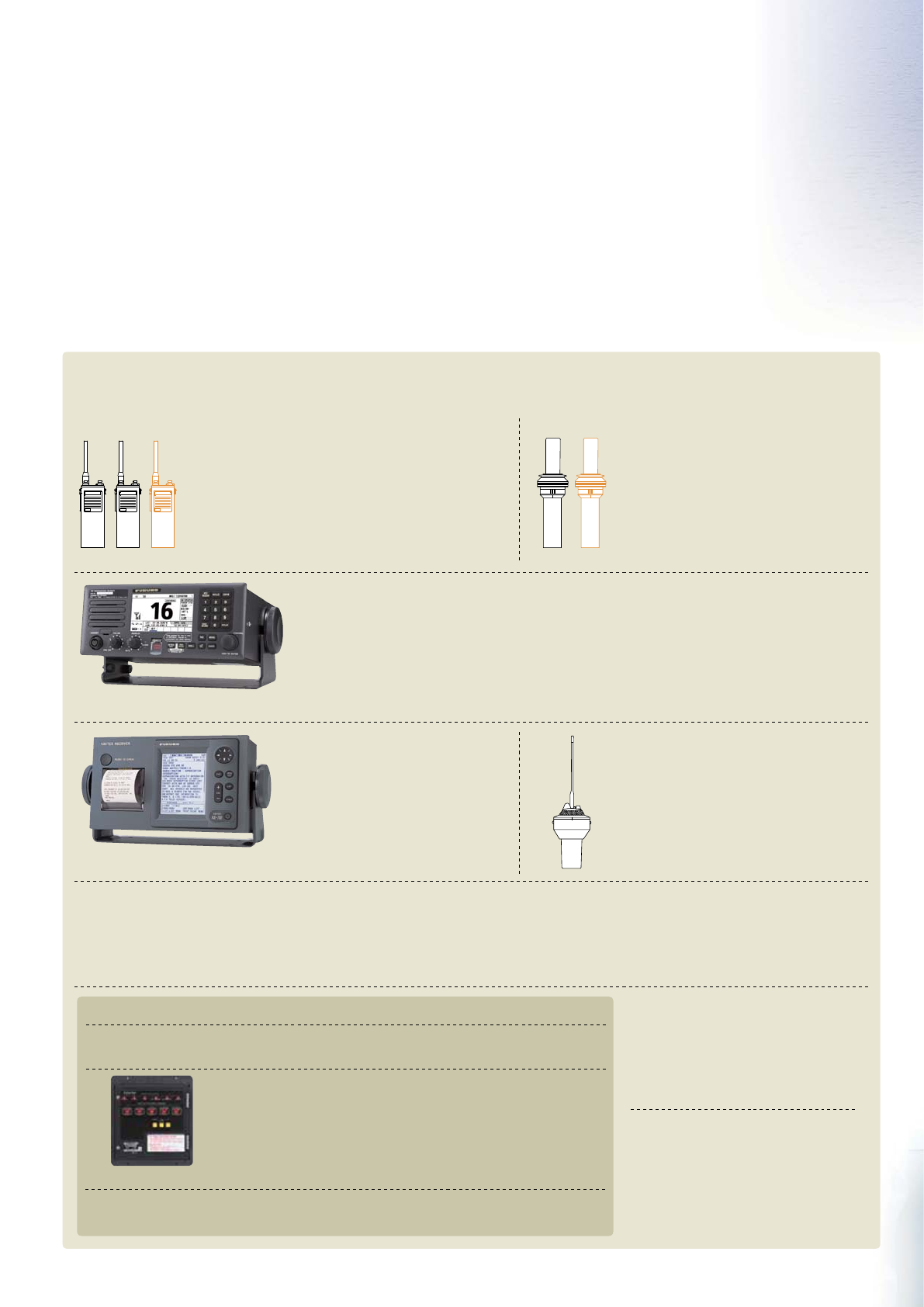
**For areas where there is no coastal radio station
handling MF/HF general communications, Inmarsat-C
mobile earth station may be used to fulfill the
requirement for general communications.
MF/HF radiotelephone with
built-in
DSC/DSC Watch Receiver
Carriage/functional requirements for GMDSS
General functional requirements for GMDSS
System suggestions for GMDSS
General requirement for equipment and functions for all ships irrespective
of the operating sea area
Additional equipment to be installed on ships operating in the Sea Areas:
Maintenance requirement for ships operating in Sea Area
and
Two-way VHF radiotelephone apparatus
Inmarsat EGC receiver
Arrangements required only for all passenger ships
VHF radiotelephone with DSC and DSC Watch Receiver capable of:
Functional requirements to be fulfilled by FS-xx75:
Other functional requirements
International NAVTEX Receiver
A distress panel at the conning position
If the satellite EPIRB is used as the secondary means
of distress alerting and not remotely activated, it is
acceptable to have an additional EPIRB installed close
to the conning position.
Search and rescue locating
device
(SART: either by radar transponder
operating in the 9 GHz band or AIS-SART)
406 MHz EPIRB
At least two two-way VHF radiotelephone
apparatus required for cargo ships of 300-500 GT
At least three two-way VHF radiotelephone
apparatus required for all passenger ships and
cargo ships of 500 GT and upwards
Note: There is no additional equipment required for ships operating exclusively in the Sea Area A1
Required if the ships operate within Inmarsat coverage but outside the international NAVTEX service area. However,
ships operating exclusively in areas where an HF direct-printing telegraphy maritime safety information service is
provided and fitted with equipment capable of receiving such service may be exempted from this requirement.
Two-way radiotelephone for on-scene search and rescue communication using
frequencies 121.5 MHz and 123.1 MHz
Permanently arranged electrical
lighting for illuminating
the control panel of the
radiocommunications
equipment
Automatic provision of position
from an internal or external
navigation sensor for all two-
way communication equipment
that includes ship's position in
the distress alert
Automatic and continuous update of position for all relevant radiocommunication
equipment to be included in the initial distress alert activated through the distress panel
◆ Transmission/reception of DSC on CH 70 (156.525 MHz);
◆ Transmission/reception of radiotelephony on CH 6 (156.300 MHz), CH 13 (156.650 MHz)
and CH 16 (156.800 MHz); and
◆ Continuous watch on CH 70 (156.525 MHz)
◆ Distress and safety communications on MF
(2,187.5 kHz using DSC* and 2,182 kHz using radiotelephony)
*It should be possible that transmission of distress alerts be initiated from the navigation bridge.
◆ Continuous DSC watch on the frequency 2,187.5 kHz
◆ Transmission and reception of general
communications using radiotelephony or
direct-printing telegraphy**
Transmission of ship-to-shore distress
alerts by radio service other than MF
(to be fulfilled by 406 MHz satellite
EPIRB)
At least one SART required for cargo
ships of 300-500 GT
At least two SART required for all
passenger ships and cargo ships of
500 GT and upwards
In order to ensure the maintenance requirements specified in SOLAS Reg. IV/15,
one of the following measures should be taken as may be approved by the flag
administrations:
• Duplication of equipment;
• Shore-based maintenance; or
• At sea electronic maintenance capability
Please consult with the flag administrations for details.
1 Transmission of ship-to-shore distress alerts by at least
two separate and independent means, using different
radiocommunication service;
2 Reception of shore-to-ship distress alerts;
3 Transmission/reception of ship-to-ship distress alerts;
4 Transmission/reception of search and rescue co-ordinating
communications;
(Emergency Position
Indicating Radio Beacon)
Model: FM-8900S
FS-1575/2575/5075
Inmarsat-C Mobile Earth Station
FELCOM18
Model: NX-700
Model: IC-350
5 Transmission/reception of on-scene communications;
6 Transmission/reception of SART signals for locating;
7 Transmission/reception of maritime safety information;
8 Transmission/reception of general radiocommunications to
and from shore-based radio systems or networks; and
9 Transmission/reception of bridge-to-bridge communications.
VHF radiotelephone with
built-in
DSC/DSC Watch Receiver
FM-8900S
DUPLICATION OF EQUIPMENT
REQUIRED FOR SHIPS
OPERATING IN SEA AREA A1 and A2
3
4














